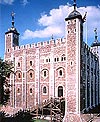![]() Anglo-Norman
Military Architecture
Anglo-Norman
Military Architecture

 Structures
in early Norman castles were usually built of timber. None of them exists
today, but a few surviving church towers of the period suggest the keep, at
least, might have been a very sophisticated building. The use of stone became
common in the 12th century as castles became permanent features in the landscape
and had to resist improving siege techniques. Typically, a stone wall of the
period was built above a solid trench-built foundation of mortared rubble.
This was also used for the core of the wall itself which usually had a facing
of neatly cut blocks.
Structures
in early Norman castles were usually built of timber. None of them exists
today, but a few surviving church towers of the period suggest the keep, at
least, might have been a very sophisticated building. The use of stone became
common in the 12th century as castles became permanent features in the landscape
and had to resist improving siege techniques. Typically, a stone wall of the
period was built above a solid trench-built foundation of mortared rubble.
This was also used for the core of the wall itself which usually had a facing
of neatly cut blocks.
The first structure to be built, or rebuilt, in stone was usually the keep which was set at ground level, as an earthen motte would not bear its weight. The keep at Colchester (c. 1070-1) and the White Tower at the Tower of London (c.1080) are early examples, although they were as much royal palaces as purely military buildings.

 The classic Norman stone keep was a
fortified tower with a near square ground plan. Inside, the main rooms were
stacked one above the other and the ceilings often employed the new vaulting
techniques of the period. On the ground floor there was usually a store and
prison and on the first floor was the hall used for public business and accessible
through the main entrance, often approached byremovable
wooden stairs.Above the hall was the lord's private suite.
The classic Norman stone keep was a
fortified tower with a near square ground plan. Inside, the main rooms were
stacked one above the other and the ceilings often employed the new vaulting
techniques of the period. On the ground floor there was usually a store and
prison and on the first floor was the hall used for public business and accessible
through the main entrance, often approached byremovable
wooden stairs.Above the hall was the lord's private suite.  There were recesses
in the walls for cupboards, fireplaces and even latrines. Around the roof
ran a wall walk protected by a crenellated parapet. Stone was also used for
the castle's gate house and outer wall on account of their exposed position
in any attack.
There were recesses
in the walls for cupboards, fireplaces and even latrines. Around the roof
ran a wall walk protected by a crenellated parapet. Stone was also used for
the castle's gate house and outer wall on account of their exposed position
in any attack.
New ideas on military architecture in the late 12th century included keeps with plans of polygonal or circular form with outer buttresses. In theory they were stronger and needed less masonry than a traditional keep. In addition, there was a greater use of towers on the curtain wall than hitherto and outside the wall defensive ditches were greatly increased in size.